Development of Poly(2-Methacryloyloxyethyl Phosphorylcholine)-Functionalized Hydrogels for Reducing Protein and Bacterial Adsorption
Abstract
1. Introduction
2. Materials and Methods
2.1. Chemicals and Equipment
2.2. Synthesis of HEMA-Based Hydrogels
2.3. Surface-Functionalization of p(HEMA) Hydrogels with p(MPC)
2.4. Optical Transmittance Measurement of the p(HEMA)/p(MPC) Hydrogels
2.5. Equilibrium Swelling of the p(HEMA)/p(MPC) Hydrogels
2.6. Contact Angle Measurement of the p(HEMA)/p(MPC) Hydrogels
2.7. Protein Desorption from the p(HEMA)/p(MPC) Hydrogels
2.8. In Vitro Bacterial Desorption Test of the p(HEMA)/p(MPC) Hydrogels
2.9. Statistical Analysis
3. Results and Discussion
4. Conclusions
Author Contributions
Funding
Acknowledgments
Conflicts of Interest
References
- Marklein, R.A.; Burdick, J.A. Spatially controlled hydrogel mechanics to modulate stem cell interactions. Soft Matter. 2010, 6, 136–143. [Google Scholar] [CrossRef]
- Kim, B.; Kang, B.; Vales, T.P.; Yang, S.K.; Lee, J.; Kim, H.J. Polyphenol-Functionalized Hydrogels Using an Interpenetrating Chitosan Network and Investigation of Their Antioxidant Activity. Macromol. Res. 2018, 26, 35–39. [Google Scholar] [CrossRef]
- Parhi, R. Cross-Linked Hydrogel for Pharmaceutical Applications: A Review. Adv. Pharm. Bull. 2017, 7, 515–530. [Google Scholar] [CrossRef] [PubMed]
- Jones, D.S.; McLaughlin, D.W.J.; McCoy, C.P.; Gorman, S.P. Physicochemical characterisation and biological evaluation of hydrogel-poly (ε-caprolactone) interpenetrating polymer networks as novel urinary biomaterials. Biomaterials 2005, 26, 1761–1770. [Google Scholar] [CrossRef] [PubMed]
- Flynn, L.; Dalton, P.D.; Shoichet, M.S. Fiber templating of poly (2-hydroxyethyl methacrylate) for neural tissue engineering. Biomaterials 2003, 24, 4265–4272. [Google Scholar] [CrossRef]
- Michelsen, V.B.; Moe, G.; Strøm, M.B.; Jensen, E.; Lygre, H. Quantitative analysis of TEGDMA and HEMA eluted into saliva from two dental composites by use of GC/MS and tailor-made internal standards. Dent. Mater. 2008, 24, 724–731. [Google Scholar] [CrossRef]
- Dziubla, T.D.; Torjman, M.C.; Joseph, J.I.; Murphy-Tatum, M.; Lowman, A.M. Evaluation of porous networks of poly (2-hydroxyethyl methacrylate) as interfacial drug delivery devices. Biomaterials 2001, 22, 2893–2899. [Google Scholar] [CrossRef]
- Kwon, O.H.; Nho, Y.C.; Lee, Y.M. Radiation-induced copolymerization of 2-hydroxyethyl methacrylate and polyethylene glycol methacrylate, and its protein adsorption and bacterial attachment. J. Ind. Eng. Chem. 2003, 9, 138–145. [Google Scholar]
- Lloyd, A.W.; Faragher, R.G.A.; Denyer, S.P. Ocular biomaterials and implants. Biomaterials 2001, 22, 769–785. [Google Scholar] [CrossRef]
- Parsons, C.; Jones, D.S.; Gorman, S.P. The intraocular lens: Challenges in the prevention and therapy of infectious endophthalmitis and posterior capsular opacification. Expert Rev. Med. Devices 2005, 2, 161–173. [Google Scholar] [CrossRef]
- Abraham, S.; Brahim, S.; Ishihara, K.; Guiseppi-Elie, A. Molecularly engineered p (HEMA)-based hydrogels for implant biochip biocompatibility. Biomaterials 2005, 26, 4767–4778. [Google Scholar] [CrossRef] [PubMed]
- Bai, T.; Zhang, P.; Han, Y.; Liu, Y.; Liu, W.; Zhao, X.; Lu, W. Construction of an ultrahigh strength hydrogel with excellent fatigue resistance based on strong dipole-dipole interaction. Soft Matter. 2011, 7, 2825–2831. [Google Scholar] [CrossRef]
- Tomić, S.L.; Suljovrujić, E.H.; Filipović, J.M. Biocompatible and bioadhesive hydrogels based on 2-hydroxyethyl methacrylate, monofunctional poly (alkylene glycol) s and itaconic acid. Polym. Bull. 2006, 57, 691–702. [Google Scholar] [CrossRef]
- Carr, L.R.; Xue, H.; Jiang, S. Functionalizable and nonfouling zwitterionic carboxybetaine hydrogels with a carboxybetaine dimethacrylate crosslinker. Biomaterials 2011, 32, 961–968. [Google Scholar] [CrossRef] [PubMed]
- Bozukova, D.; Pagnoulle, C.; De Pauw-Gillet, M.C.; Ruth, N.; Jérôme, R.; Jérôme, C. Imparting antifouling properties of poly(2-hydroxyethyl methacrylate) hydrogels by grafting poly(oligoethylene glycol methyl ether acrylate). Langmuir 2008, 24, 6649–6658. [Google Scholar] [CrossRef] [PubMed]
- Goda, T.; Ishihara, K.; Miyahara, Y. Critical update on 2-methacryloyloxyethyl phosphorylcholine (MPC) polymer science. J. Appl. Polym. Sci. 2015, 132, 1–10. [Google Scholar] [CrossRef]
- Lim, H.; Kim, H.; Jun, J. Development of Hyaluronic Acid-Functionalized Hydrogel Lens and Characterization of Physical Properties and Lysozyme Adsorption. J. Korean Ophthalmic Opt. Soc. 2015, 20, 285–291. [Google Scholar] [CrossRef]
- Perrino, C.; Lee, S.; Choi, S.W.; Maruyama, A.; Spencer, N.D. A biomimetic alternative to poly (ethylene glycol) as an antifouling coating: Resistance to nonspecific protein adsorption of poly (L-lysine)-graft-dextran. Langmuir 2008, 24, 8850–8856. [Google Scholar] [CrossRef]
- Heo, S.; Jeon, Y.S.; Kim, S.I.; Kim, S.H.; Kim, J.H. Bioinspired adhesive coating on PET film for antifouling surface modification. Macromol. Res. 2014, 22, 203–209. [Google Scholar] [CrossRef]
- Thissen, H.; Gengenbach, T.; du Toit, R.; Sweeney, D.F.; Kingshott, P.; Griesser, H.J.; Meagher, L. Clinical observations of biofouling on PEO coated silicone hydrogel contact lenses. Biomaterials 2010, 31, 551–5519. [Google Scholar] [CrossRef]
- Rahman, M.M.; Chun, H.H.; Park, H. Preparation and properties of waterborne polyurethane-silane: A promising antifouling coating. Macromol. Res. 2011, 19, 8–13. [Google Scholar] [CrossRef]
- Kim, H.J.; Ryu, G.C.; Jeong, K.S.; Jun, J. Hydrogel lenses functionalized with polysaccharide for reduction of protein adsorption. Macromol. Res. 2014, 23, 74–78. [Google Scholar] [CrossRef]
- Ishihara, K.; Ueda, T.; Nakabayashi, N. Preparation of phospholipid polylners and their properties as polymer hydrogel membranes. Polym. J. 1990, 22, 355. [Google Scholar] [CrossRef]
- Ng, V.W.L.; Chan, J.M.W.; Sardon, H.; Ono, R.J.; Garcia, J.M.; Yang, Y.Y.; Hedrick, J.L. Antimicrobial hydrogels: A new weapon in the arsenal against multidrug-resistant infections. Adv. Drug Deliv. Rev. 2014, 78, 46–62. [Google Scholar] [CrossRef] [PubMed]
- Zhang, L.; Cao, Z.; Bai, T.; Carr, L.; Ella-Menye, J.R.; Irvin, C.; Ratner, B.D.; Jiang, S. Zwitterionic hydrogels implanted in mice resist the foreign-body reaction. Nat. Biotechnol. 2013, 31, 553. [Google Scholar] [CrossRef] [PubMed]
- Olivier, A.; Meyer, F.; Raquez, J.M.; Damman, P.; Dubois, P. Surface-initiated controlled polymerization as a convenient method for designing functional polymer brushes: From self-assembled monolayers to patterned surfaces. Prog. Polym. Sci. 2012, 37, 157–181. [Google Scholar] [CrossRef]
- Koepsel, J.T.; Murphy, W.L. Patterned Self-Assembled Monolayers: Efficient, Chemically Defined Tools for Cell Biology. Chem. Bio. Chem. 2012, 13, 1717–1724. [Google Scholar] [CrossRef]
- Galvin, C.J.; Genzer, J. Applications of surface-grafted macromolecules derived from post-polymerization modification reactions. Prog. Polym. Sci. 2012, 37, 871–906. [Google Scholar] [CrossRef]
- Yang, W.J.; Pranantyo, D.; Neoh, K.G.; Kang, E.T.; Teo, S.L.M.; Rittschof, D. Layer-by-layer click deposition of functional polymer coatings for combating marine biofouling. Biomacromolecules 2012, 13, 2769–2780. [Google Scholar] [CrossRef]
- Zhu, X.; Guo, S.; Jańczewski, D.; Parra Velandia, F.J.; Teo, S.L.M.; Vancso, G.J. Multilayers of fluorinated amphiphilic polyions for marine fouling prevention. Langmuir 2013, 30, 288–296. [Google Scholar] [CrossRef]
- Kim, M.; Kim, Y.J.; Gwon, K.; Tae, G. Modulation of cell adhesion of heparin-based hydrogel by efficient physisorption of adhesive proteins. Macromol. Res. 2012, 20, 271–276. [Google Scholar] [CrossRef]
- Ahn, J.; Sohn, E.H.; Bang, S.H.; Kang, J.; Kim, T.; Hong, H.; Kim, S.E.; Kim, B.S.; Yoon, J.; Lee, J.C. Biocompatible Ag nanoparticle-embedded poly (2-hydroxyethyl methacrylate) derivative films with bacterial adhesion-resistant and antibacterial properties. Macromol. Res. 2014, 22, 337–343. [Google Scholar] [CrossRef]
- Iwasaki, Y.; Nakabayashi, N.; Ishihara, K. Preservation of platelet function on 2-methacryloyloxyethyl phosphorylcholine–graft polymer as compared to various water-soluble graft polymers. J. Biomed. Mater. Res. 2001, 57, 72–78. [Google Scholar] [CrossRef]
- Xu, Y.; Takai, M.; Ishihara, K. Protein adsorption and cell adhesion on cationic, neutral, and anionic 2-methacryloyloxyethyl phosphorylcholine copolymer surfaces. Biomaterials 2009, 30, 4930–4938. [Google Scholar] [CrossRef] [PubMed]
- Choi, J.R.; Yong, K.W.; Choi, J.Y.; Cowie, A.C. Recent advances in photo-crosslinkable hydrogels for biomedical applications. BioTechniques 2019, 66, 40–53. [Google Scholar] [CrossRef] [PubMed]
- Jiang, S.; Cao, Z. Ultralow-fouling, functionalizable, and hydrolyzable zwitterionic materials and their derivatives for biological applications. Adv. Mater. 2010, 22, 920–932. [Google Scholar] [CrossRef] [PubMed]
- Chen, S.; Zheng, J.; Li, L.; Jiang, S. Strong resistance of phosphorylcholine self-assembled monolayers to protein adsorption: Insights into nonfouling properties of zwitterionic materials. J. Am. Chem. Soc. 2005, 127, 14473–14478. [Google Scholar] [CrossRef]
- He, M.; Gao, K.; Zhou, L.; Jiao, Z.; Wu, M.; Cao, J.; You, X.; Cai, Z.; Su, Y.; Jiang, Z. Zwitterionic materials for antifouling membrane surface construction. Acta Biomater. 2016, 40, 142–152. [Google Scholar] [CrossRef]
- Schroeder, M.E.; Zurick, K.M.; McGrath, D.E.; Bernards, M.T. Multifunctional polyampholyte hydrogels with fouling resistance and protein conjugation capacity. Biomacromolecules 2013, 14, 3112–3122. [Google Scholar] [CrossRef]
- Chen, S.; Li, L.; Zhao, C.; Zheng, J. Surface hydration: Principles and applications toward low-fouling/nonfouling biomaterials. Polymer 2010, 51, 5283–5293. [Google Scholar] [CrossRef]
- Bretscher, M.S.; Raff, M.C. Mammalian plasma membranes. Nature 1975, 258, 43. [Google Scholar] [CrossRef]
- Park, J.U.; Ham, J.; Kim, S.; Seo, J.H.; Kim, S.H.; Lee, S.; Min, H.J.; Choi, S.; Choi, R.M.; Kim, H.; et al. Alleviation of capsular formations on silicone implants in rats using biomembrane-mimicking coatings. Acta Biomater. 2014, 10, 4217–4225. [Google Scholar] [CrossRef] [PubMed]
- Iwasaki, Y.; Sawada, S.I.; Nakabayashi, N.; Khang, G.; Lee, H.B.; Ishihara, K. The effect of the chemical structure of the phospholipid polymer on fibronectin adsorption and fibroblast adhesion on the gradient phospholipid surface. Biomaterials 1999, 20, 2185–2191. [Google Scholar] [CrossRef]
- Ishihara, K.; Tanaka, S.; Furukawa, N.; Nakabayashi, N.; Kurita, K. Improved blood compatibility of segmented polyurethanes by polymeric additives having phospholipid polar groups. I. Molecular design of polymeric additives and their functions. J. Biomed. Mater. Res. A 1996, 32, 391–399. [Google Scholar] [CrossRef]
- Yoneyama, T.; Ito, M.; Sugihara, K.I.; Ishihara, K.; Nakabayashi, N. Small diameter vascular prosthesis with a nonthrombogenic phospholipid polymer surface: Preliminary study of a new concept for functioning in the absence of pseudo-or neointima formation. Artif. Organs 2000, 24, 23–28. [Google Scholar] [CrossRef]
- Zhang, Z.; Chen, S.; Chang, Y.; Jiang, S. Surface grafted sulfobetaine polymers via atom transfer radical polymerization as superlow fouling coatings. J. Phys Chem. B 2006, 110, 10799–10804. [Google Scholar] [CrossRef] [PubMed]
- Ishihara, K.; Nomura, H.; Mihara, T.; Kurita, K.; Iwasaki, Y.; Nakabayashi, N. Why do phospholipid polymers reduce protein adsorption? J. Biomed. Mater. Res. 1998, 39, 323–330. [Google Scholar] [CrossRef]
- Kim, J.; Somorjai, G.A. Molecular packing of lysozyme, fibrinogen, and bovine serum albumin on hydrophilic and hydrophobic surfaces studied by infrared−visible sum frequency generation and fluorescence microscopy. J. Am. Chem. Soc. 2003, 125, 3150–3158. [Google Scholar] [CrossRef]
- Polakova, L.; Raus, V.; Kostka, L.; Braunova, A.; Pilar, J.; Lobaz, V.; Pánek, J.; Sedláková, Z. Antioxidant properties of 2-hydroxyethyl methacrylate-based copolymers with incorporated sterically hindered amine. Biomacromolecules 2015, 16, 2726–2734. [Google Scholar] [CrossRef]
- Kiritoshi, Y.; Ishihara, K. Preparation of cross-linked biocompatible poly (2-methacryloyloxyethyl phosphorylcholine) gel and its strange swelling behavior in water/ethanol mixture. J. Biomater. Sci. Polym. Ed. 2002, 13, 213–224. [Google Scholar] [CrossRef]
- Jee, J.P.; Kim, H.J. Development of hydrogel lenses with surface-immobilized PEG layers to reduce protein adsorption. Bull. Korean Chem. Soc. 2015, 36, 2682–2687. [Google Scholar] [CrossRef]
- Moore, W.M.; Hammond, G.S.; Foss, R.P. Mechanisms of photoreactions in solutions. I. Reduction of benzophenone by benzhydrol. J. Am. Chem. Soc. 1961, 83, 2789–2794. [Google Scholar] [CrossRef]
- Yin, Y.; Yang, Y.; Xu, H. Swelling behavior of hydrogels for colon-site drug delivery. J. Appl. Polym. Sci. 2002, 83, 2835–2842. [Google Scholar] [CrossRef]
- Ahmed, T.A.E.; Hincke, M.T. Strategies for articular cartilage lesion repair and functional restoration. Tissue Eng. Part B Rev. 2010, 16, 305–329. [Google Scholar] [CrossRef] [PubMed]
- Garrett, Q.; Laycock, B.; Garrett, R.W. Hydrogel lens monomer constituents modulate protein sorption. Investig. Ophthalmol. Vis. Sci. 2000, 41, 1687–1695. [Google Scholar]
- Li, L.; Wang, J.H.; Xin, Z. Synthesis and biocompatibility of a novel silicone hydrogel containing phosphorylcholine. Eur. Polym. J. 2011, 47, 1795–1803. [Google Scholar] [CrossRef]
- Iwata, R.; Satoh, R.; Iwasaki, Y.; Akiyoshi, K. Covalent immobilization of antibody fragments on well-defined polymer brushes via site-directed method. Colloids Surf. B Biointerfaces 2008, 62, 288–298. [Google Scholar] [CrossRef]
- Kobayashi, M.; Terayama, Y.; Hosaka, N.; Kaido, M.; Suzuki, A.; Yamada, N.; Torikai, N.; Ishihara, K.; Takahara, A. Friction behavior of high-density poly (2-methacryloyloxyethyl phosphorylcholine) brush in aqueous media. Soft Matter 2007, 3, 740–746. [Google Scholar] [CrossRef]
- Ketelson, H.A.; Perry, S.S.; Sawyer, W.G.; Jacob, J.T. Exploring the Science and Technology of Contact Lens Comfort. Comfort. Contact Lens Spectr. 2011, 26, 30–36. [Google Scholar]
- Seo, J.H.; Matsuno, R.; Konno, T.; Takai, M.; Ishihara, K. Surface tethering of phosphorylcholine groups onto poly (dimethylsiloxane) through swelling–deswelling methods with phospholipids moiety containing ABA-type block copolymers. Biomaterials 2008, 29, 1367–1376. [Google Scholar] [CrossRef]
- Ratner, B.D.; Bryant, S.J. Biomaterials: Where we have been and where we are going. Annu. Rev. Biomed. Eng. 2004, 6, 41–75. [Google Scholar] [CrossRef]
- Kung, F.C.; Yang, M.C. Effect of conjugated linoleic acid immobilization on the hemocompatibility of cellulose acetate membrane. Colloids Surf. B Biointerfaces 2006, 47, 36–42. [Google Scholar] [CrossRef] [PubMed]
- Sheng, Q.; Schulten, K.; Pidgeon, C. Molecular dynamic simulation of immobilized artificial membranes. J. Phys. Chem. 1995, 99, 11018–11027. [Google Scholar] [CrossRef]
- Chapman, D. Biomembranes and new hemocompatible materials. Langmuir 1993, 9, 39–45. [Google Scholar] [CrossRef]
- Goda, T.; Matsuno, R.; Konno, T.; Takai, M.; Ishihara, K. Protein adsorption resistance and oxygen permeability of chemically crosslinked phospholipid polymer hydrogel for ophthalmologic biomaterials. J. Biomed. Mater. Res. Part B Appl. Biomater. 2009, 89, 184–190. [Google Scholar] [CrossRef]
- Ishihara, K.; Mu, M.; Konno, T.; Inoue, Y.; Fukazawa, K. The unique hydration state of poly (2-methacryloyloxyethyl phosphorylcholine). J. Biomater. Sci. Polym. Ed. 2017, 28, 884–899. [Google Scholar] [CrossRef] [PubMed]
- Wang, J.J.; Liu, F. Photoinduced graft polymerization of 2-methacryloyloxyethyl phosphorylcholine on silicone hydrogels for reducing protein adsorption. J. Mater. Sci. Mater. Med. 2011, 22, 2651–2657. [Google Scholar] [CrossRef]
- Chae, K.H.; Jang, Y.M.; Kim, Y.H.; Sohn, O.J.; Rhee, J.I. Anti-fouling epoxy coatings for optical biosensor application based on phosphorylcholine. Sens. Actuators B Chem. 2007, 124, 153–160. [Google Scholar] [CrossRef]
- Huang, X.D.; Yao, K.; Zhang, H.; Huang, X.J.; Xu, Z.K. Surface modification of silicone intraocular lens by 2-methacryloyloxyethyl phosphoryl-choline binding to reduce Staphylococcus epidermidis adherence. Clin. Exp. Ophthalmol. 2007, 35, 462–467. [Google Scholar] [CrossRef]
- Rojas, J.J.; Ochoa, V.J.; Ocampo, S.A.; Muñoz, J.F. Screening for antimicrobial activity of ten medicinal plants used in Colombian folkloric medicine: A possible alternative in the treatment of non-nosocomial infections. BMC Complement. Altern. Med. 2006, 6, 2. [Google Scholar] [CrossRef]
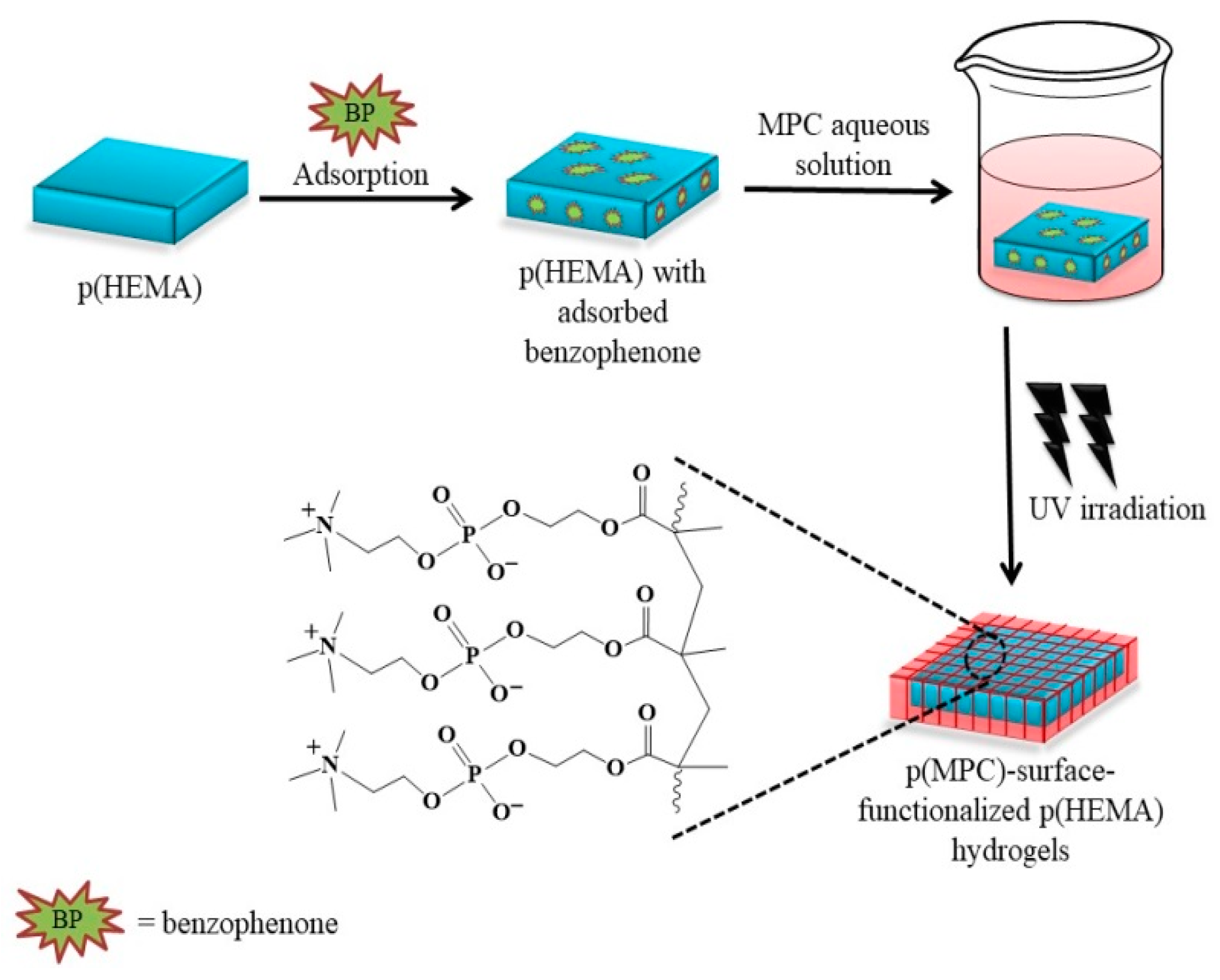
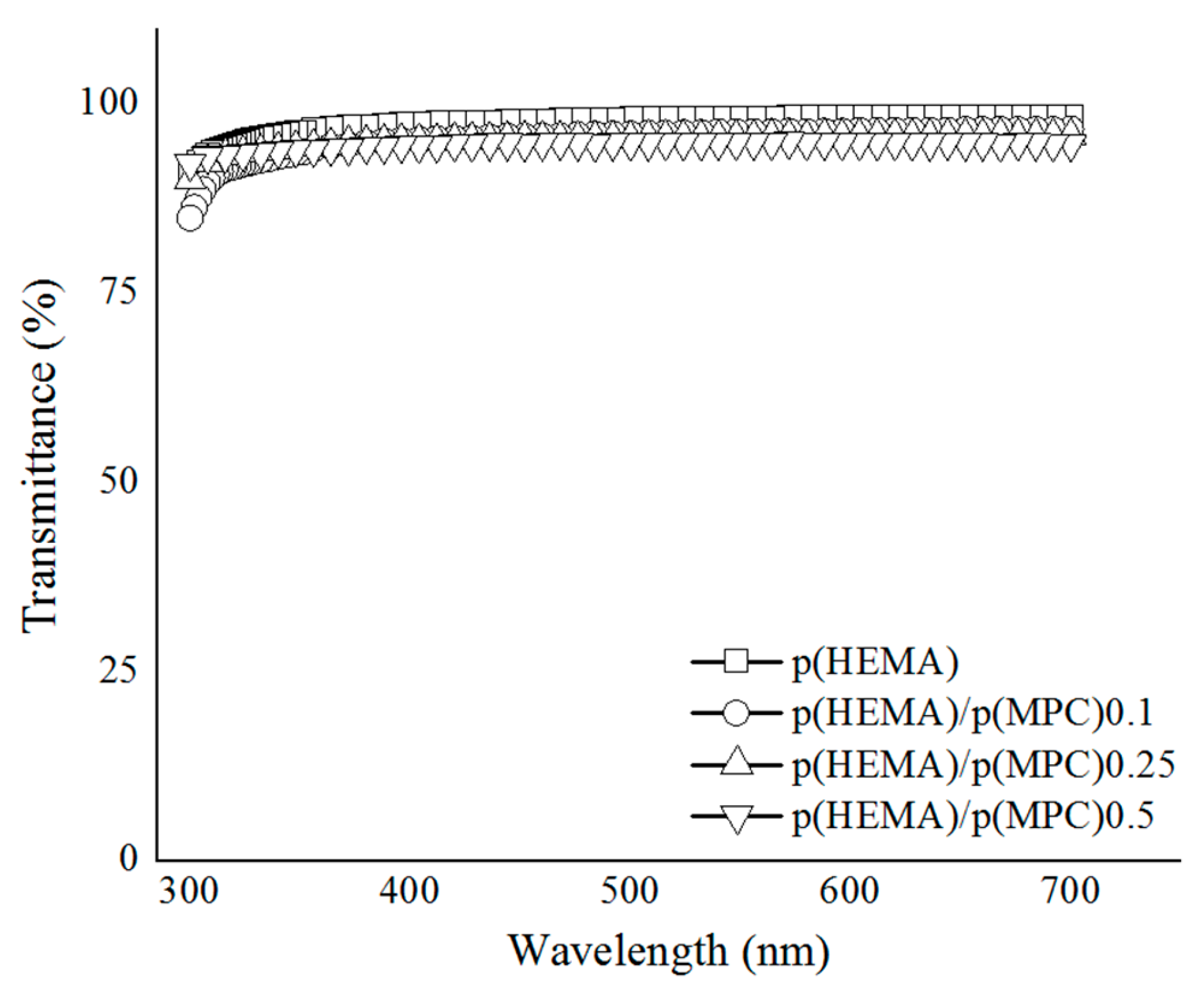
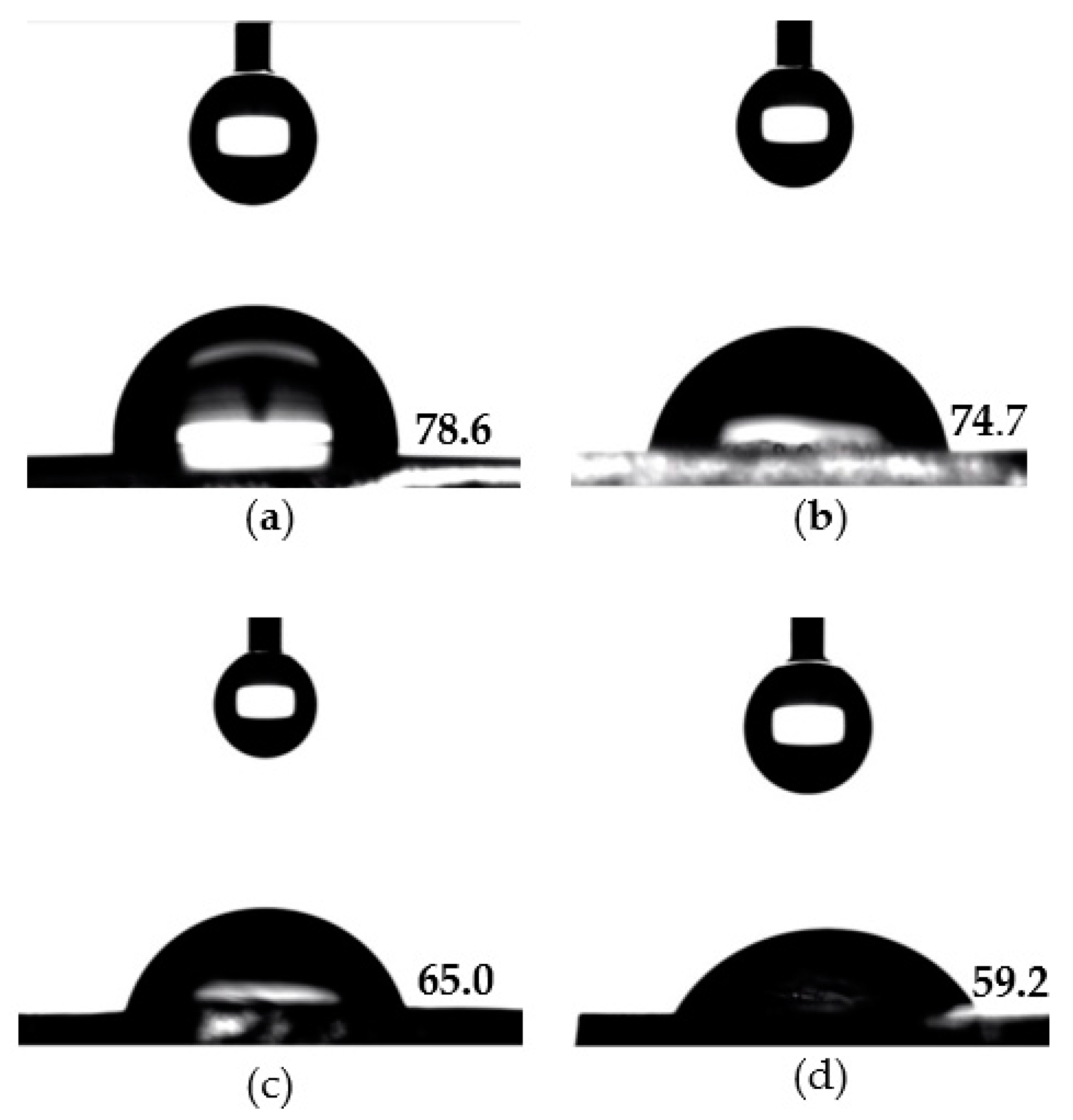
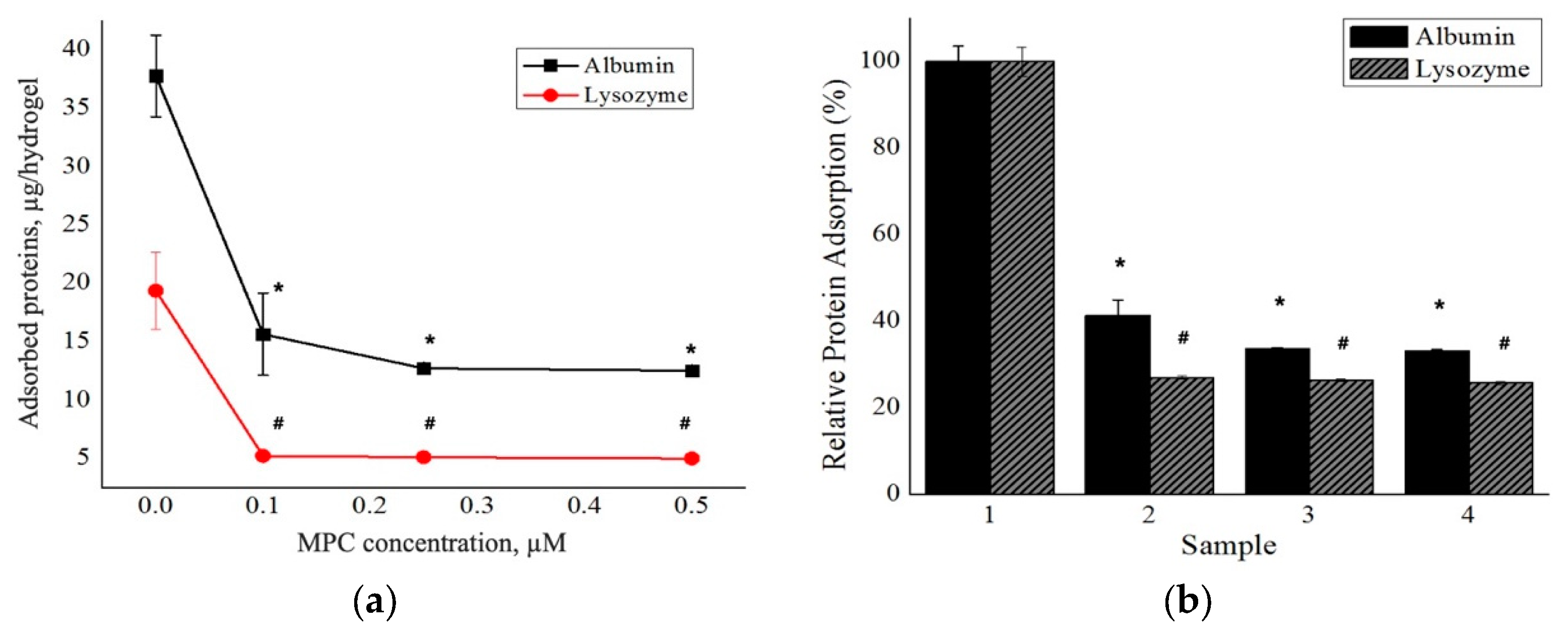
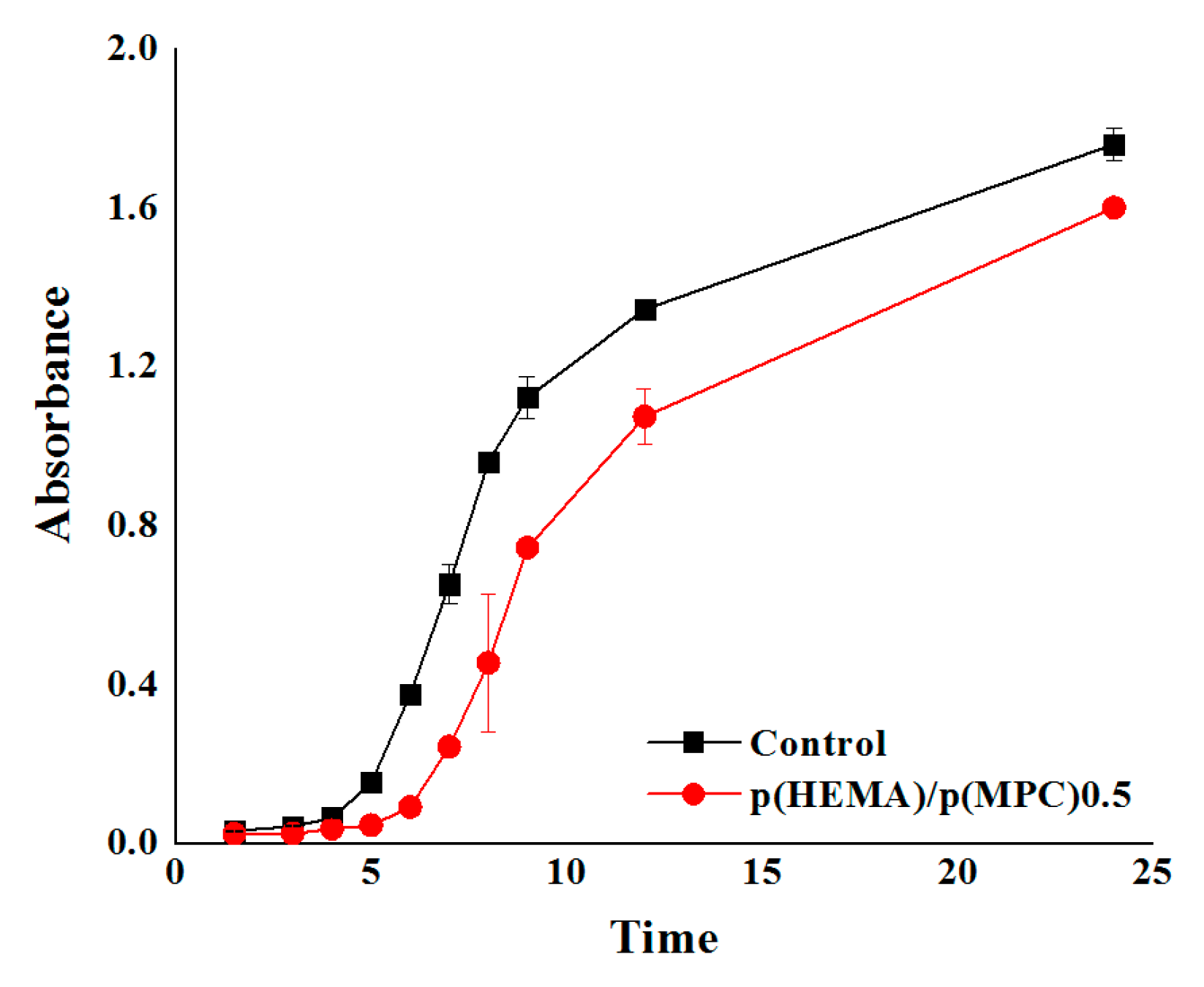
| Hydrogels | Amounts of Conjugated poly(MPC) (μmol/cm2 per Hydrogel Surface) 1 | Equilibrium Swelling Ratio (%)1 | Contact Angle (°) 2 |
|---|---|---|---|
| p(HEMA) 3 | – | 60.1 ± 1.1 | 78.6 ± 9.6 |
| p(HEMA)/p(MPC)0.1 | 18.0 ± 1.2 | 61.0 ± 2.9 | 74.7 ± 9.7 |
| p(HEMA)/p(MPC)0.25 | 21.8 ± 0.5 | 61.6 ± 1.0 | 65.0 ± 4.7 4 |
| p(HEMA)/p(MPC)0.5 | 24.1 ± 1.8 | 68.3 ± 1.3 | 59.2 ± 7.0 4,5 |
© 2020 by the authors. Licensee MDPI, Basel, Switzerland. This article is an open access article distributed under the terms and conditions of the Creative Commons Attribution (CC BY) license (http://creativecommons.org/licenses/by/4.0/).
Share and Cite
Vales, T.P.; Jee, J.-P.; Lee, W.Y.; Cho, S.; Lee, G.M.; Kim, H.-J.; Kim, J.S. Development of Poly(2-Methacryloyloxyethyl Phosphorylcholine)-Functionalized Hydrogels for Reducing Protein and Bacterial Adsorption. Materials 2020, 13, 943. https://doi.org/10.3390/ma13040943
Vales TP, Jee J-P, Lee WY, Cho S, Lee GM, Kim H-J, Kim JS. Development of Poly(2-Methacryloyloxyethyl Phosphorylcholine)-Functionalized Hydrogels for Reducing Protein and Bacterial Adsorption. Materials. 2020; 13(4):943. https://doi.org/10.3390/ma13040943
Chicago/Turabian StyleVales, Temmy Pegarro, Jun-Pil Jee, Won Young Lee, Sung Cho, Gye Myung Lee, Ho-Joong Kim, and Jung Suk Kim. 2020. "Development of Poly(2-Methacryloyloxyethyl Phosphorylcholine)-Functionalized Hydrogels for Reducing Protein and Bacterial Adsorption" Materials 13, no. 4: 943. https://doi.org/10.3390/ma13040943
APA StyleVales, T. P., Jee, J.-P., Lee, W. Y., Cho, S., Lee, G. M., Kim, H.-J., & Kim, J. S. (2020). Development of Poly(2-Methacryloyloxyethyl Phosphorylcholine)-Functionalized Hydrogels for Reducing Protein and Bacterial Adsorption. Materials, 13(4), 943. https://doi.org/10.3390/ma13040943






